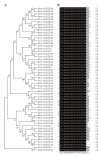The miR393-Target Module Regulates Plant Development and Responses to Biotic and Abiotic Stresses
- PMID: 36012740
- PMCID: PMC9409142
- DOI: 10.3390/ijms23169477
The miR393-Target Module Regulates Plant Development and Responses to Biotic and Abiotic Stresses
Abstract
MicroRNAs (miRNAs), a class of endogenous small RNAs, are broadly involved in plant development, morphogenesis and responses to various environmental stresses, through manipulating the cleavage, translational expression, or DNA methylation of target mRNAs. miR393 is a conserved miRNA family present in many plants, which mainly targets genes encoding the transport inhibitor response1 (TIR1)/auxin signaling F-box (AFB) auxin receptors, and thus greatly affects the auxin signal perception, Aux/IAA degradation, and related gene expression. This review introduces the advances made on the miR393/target module regulating plant development and the plant's responses to biotic and abiotic stresses. This module is valuable for genetic manipulation of optimized conditions for crop growth and development and would also be helpful in improving crop yield through molecular breeding.
Keywords: auxin; miR393; plant development; stress response; target gene.
Conflict of interest statement
The authors declare no conflict of interest.
Figures


Similar articles
-
Regulation of auxin response by miR393-targeted transport inhibitor response protein 1 is involved in normal development in Arabidopsis.Plant Mol Biol. 2011 Dec;77(6):619-29. doi: 10.1007/s11103-011-9838-1. Epub 2011 Nov 1. Plant Mol Biol. 2011. PMID: 22042293
-
Overexpression of a miR393-resistant form of transport inhibitor response protein 1 (mTIR1) enhances salt tolerance by increased osmoregulation and Na+ exclusion in Arabidopsis thaliana.Plant Cell Physiol. 2015 Jan;56(1):73-83. doi: 10.1093/pcp/pcu149. Epub 2014 Oct 21. Plant Cell Physiol. 2015. PMID: 25336111
-
miR393 contributes to the embryogenic transition induced in vitro in Arabidopsis via the modification of the tissue sensitivity to auxin treatment.Planta. 2016 Jul;244(1):231-43. doi: 10.1007/s00425-016-2505-7. Epub 2016 Apr 4. Planta. 2016. PMID: 27040841 Free PMC article.
-
MicroRNAs Are Involved in Regulating Plant Development and Stress Response through Fine-Tuning of TIR1/AFB-Dependent Auxin Signaling.Int J Mol Sci. 2022 Jan 3;23(1):510. doi: 10.3390/ijms23010510. Int J Mol Sci. 2022. PMID: 35008937 Free PMC article. Review.
-
The interaction and integration of auxin signaling components.Plant Cell Physiol. 2012 Jun;53(6):965-75. doi: 10.1093/pcp/pcs035. Epub 2012 Mar 19. Plant Cell Physiol. 2012. PMID: 22433459 Review.
Cited by
-
Finding Balance in Adversity: Nitrate Signaling as the Key to Plant Growth, Resilience, and Stress Response.Int J Mol Sci. 2023 Sep 22;24(19):14406. doi: 10.3390/ijms241914406. Int J Mol Sci. 2023. PMID: 37833854 Free PMC article. Review.
-
The Biosynthesis Process of Small RNA and Its Pivotal Roles in Plant Development.Int J Mol Sci. 2024 Jul 12;25(14):7680. doi: 10.3390/ijms25147680. Int J Mol Sci. 2024. PMID: 39062923 Free PMC article. Review.
-
Genome-wide identification of CCO gene family in cucumber (Cucumis sativus) and its comparative analysis with A. thaliana.BMC Plant Biol. 2023 Dec 11;23(1):640. doi: 10.1186/s12870-023-04647-4. BMC Plant Biol. 2023. PMID: 38082240 Free PMC article.
-
Comparative analysis of microRNA expression profiles in shoot and root tissues of contrasting rice cultivars (Oryza sativa L.) with different salt stress tolerance.PLoS One. 2023 May 24;18(5):e0286140. doi: 10.1371/journal.pone.0286140. eCollection 2023. PLoS One. 2023. PMID: 37224116 Free PMC article.
-
MicroRNAs Involved in Nutritional Regulation During Plant-Microbe Symbiotic and Pathogenic Interactions with Rice as a Model.Mol Biotechnol. 2024 Aug;66(8):1754-1771. doi: 10.1007/s12033-023-00822-y. Epub 2023 Jul 19. Mol Biotechnol. 2024. PMID: 37468736 Review.
References
Publication types
MeSH terms
Substances
Grants and funding
LinkOut - more resources
Full Text Sources

